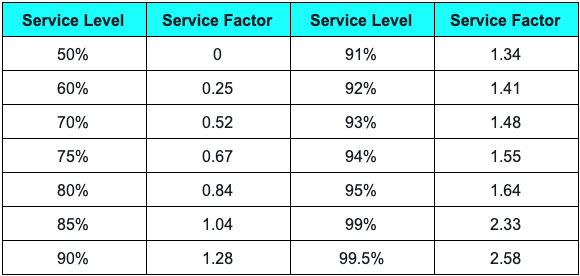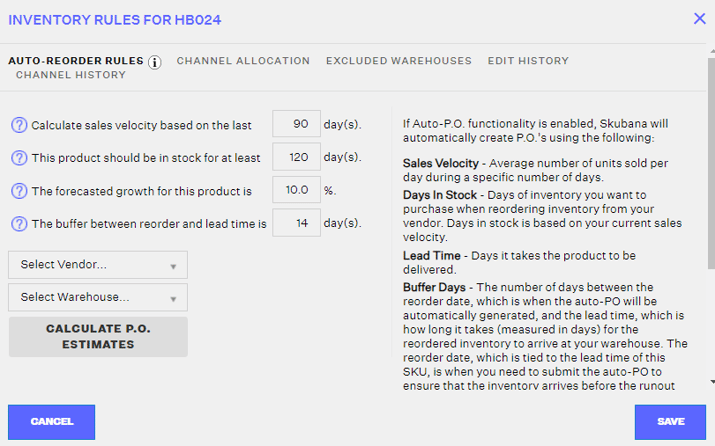Understanding how to manage your stock levels, calculate reorder points, and when to replenish your inventory ensures your business maintains a competitive edge.
However, many retail companies don't give their stock orders the attention needed to manage them correctly.
Incorrectly managing your inventory comes at a steep price and the likelihood of this happening increases as your portfolio grows.
Even companies as prolific as Ralph Lauren have seen the consequences of inventory control issues:
Over the past two years, sales have plateaued and profits have declined by 50%....Stefan Larsson, who has attributed the decline to several factors, including a lack of inventory control, which led to merchandise piling up in bargain bins and outlet malls, diluting the brand’s cachet. - Fast Company
Between calculating inventory for seasonal products to tracking cash limits for your reorders, managing stock and future order quantities can get tricky.
However, factoring reorder points and safety stock into your replenishment calculations will help you better manage your current inventory and future order quantity.
In this article, we'll show you why and how to calculate reorder points, give you a calculator, and walk through how you can let Extensiv can do the work for you.
Don't like to read? See first-hand how Extensiv can help you optimize stock levels to meet consumer demand and drive profitable growth, request a demo.
What is a Reorder Point (ROP)?
The reorder point (ROP) is the minimum number of units a business needs to have in stock to prevent stockouts and ensure order fulfillment. Once inventory levels reach the reorder point, this triggers the replenishment process to reorder that item. The ultimate goal of the reorder point is to maintain an amount of inventory at a level that can always meet customer demand without having more than is realistically possible to move. Your reorder point should include enough stock to last on hand until the delivery of new stock arrives.
The reorder point is key for business owners to determine how much safety stock a business should keep on hand as a buffer for excess demand.
How to Calculate Reorder Point
To calculate the reorder point, you need to know the reorder point formula and the two key parts of the formula: lead time demand and safety stock.
Reorder Point Formula (ROP)
The formula used to determine your inventory reorder point is relatively simple:
Reorder Point = Lead Time Demand + Safety Stock
It also plays a part in the broader scope of inventory management.
Of course, you must figure out what your lead time demand and safety stock numbers are to determine an accurate calculation. Let's first start with safety stock.
What is Safety Stock
Your safety stock is like a rainy day fund. It's the number of units of a particular item you hold in to avoid a stockout (completely running out of the product).
Safety stock protects you in several scenarios. Catastrophic weather events. Sudden changes in the demand for a product.
Your suppliers encounter trouble fulfilling an order - via shipping, manufacturing, or a shortage of raw materials. The safety stock ensures you can still fulfill orders if these happen while you wait for new inventory to arrive.
Even if you eventually run through your safety stock, having that buffer can extend your sales beyond a competitor's.
When establishing a reorder point, you want to avoid repeatedly pulling from your safety stock.
If you're continually dipping into your safety stock for reasons other than supply chain delays or unforeseen circumstances - it is a reliable indicator that you will have to increase your replenishment orders or reevaluate your safety stock levels.
Returning to our athletic apparel example, let's assume your most popular product is a unisex workout shirt. You want to determine your safety stock over a week's time frame.
Safety Stock Formula
Safety stock calculation involves determining your service level, the standard deviation of lead time, and the average demand for a product.
- The service level of the product: The higher you want your level of service for that item to be, the higher your safety stock needs to be. For the retail industry, the average level is 90%, with high-demand items targeted at a 95% service level. Remember, the higher the service level, the greater the costs dedicated to that inventory. To account for the variances in business type, you need to convert your service level percentage into the service factor or Z-score. Below is a chart that provides the necessary conversion. A 95% service level equals a 1.64 service factor.

- The standard deviation of lead time: Although your suppliers claim a specific lead time in replenishment, the truth is that the actual lead time can vary. The standard deviation of lead time takes into account the possible variances. Let's look at Supplier B with a quoted lead time of 7 days. Over their past five shipments, the actual time was 12, 8, 9, 5, and 5 days. Add up the variances between quoted and actual time to get your standard deviation:
5 + 1 + 2 + -2 + -2 = 4
- Demand average: The average demand for a particular product as expressed by your customers. To figure out this number, take your total sales number for a given timeframe – one week, two weeks, a month – and divide it over the number of buying days. If a week's worth of sales volume totals 750 units, you take 750 ÷ 7 days equals a demand average of 107 units.
The formula for safety stock is thus: desired service level * standard deviation of lead time * demand average or:
1.64 service level * 4 days of standard deviation of lead time * 107 demand average units = 702 units of safety stock
Once you have your safety stock number, you can then plug it into the reorder point formula for insight into your reorder levels.
Demand Lead Time
The reorder point formula also takes into account lead time demand.
To figure out the lead time demand, you need to multiply your lead time by the average daily sales of a specific product.
Again, let's use the workout shirt as an example.
You source the shirt from Supplier B, who has a typical lead time of 7 days.
With average daily sales of 107 units, your lead time demand is:
7 days lead time * 107 daily unit sales = 749 lead time demand.
Reorder Point Calculation
Taking into account the above, you calculate the reorder point for your unisex workout shirt as such:
749 lead time demand + 702 units of safety stock = 1,451 reorder point
You should place a new order with Supplier B once your stock hits 1,451 workout shirt units.
You'll have enough shirts left on hand - 749 units - to sustain you until the next delivery of shirts.
You also have enough safety stock - 702 units - to cover problems with Supplier B (or any point along the supply chain) or a sudden increase in demand.
Reorder Point Calculation Inputs
The reorder point varies from product to product and is primarily influenced by two critical factors - daily sales velocity and lead time.
Daily Sales Velocity
The daily sales velocity, or the average number of units you sell per day, differs for everything you sell. Each item has its own unique sales velocity.
Let's say your ecommerce store specializes in athletic apparel for adults. The reorder point will fluctuate based on numerous factors:
- Your women's apparel lines may be more popular than that of your men's clothing, requiring higher and more frequent replenishing of the former.
- You might have a single item that sells consistently, requiring you to keep it stocked often and at higher numbers than other products. For example, Apple's iPhone is far more popular than any other product they produce, so its daily sales velocity is likely higher than their laptops or iPads.
- Individual products might sell faster during specific seasons, causing your sales velocity to spike temporarily. This spike could also shift your reorder point.
To accurately calculate a product’s reorder point, it’s important to understand these factors and how they might impact your sales velocity.
Lead Time
Next, a reorder point must consider a supplier’s lead time or the amount of time it takes for an ordered shipment to arrive. Look again at your line of women's apparel.
If you source the products from three suppliers with three different lead times, each will have its own reorder point for the product. For example,
- Supplier A takes five business days to deliver an order,
- Supplier B takes seven days
For Supplier B, your reorder point will be higher because you need to account for more stock days between your order and when new stock arrives.
So why is employing a reorder point a good idea?
Without it, you lose your ability to track sales trends accurately. Knowing which products are hot items and those that are cooling off allows you to jump on new opportunities and adjust your stock to meet increased demand.
It also saves you money long-term by trimming inventory with lower sales.
You also miss the opportunity to develop a deeper understanding of your supply chain.
Delays with your suppliers create headaches with your inventory management, resulting in a scarcity of your product. If it's a sought-after item, these delays can often come at the worst possible time.
In both instances, you could end up understocking or overstocking your inventory, neither of which are suitable for your business.
Understocking can have devastating consequences for retailers and can lead to:
- Inability to make sales due to scarce or non-existent inventory
- Declining customer service, with your consumer base moving on to competitors with more reliable and consistent inventory
- Higher vendor costs for rushed purchase orders if you need to replenish stock
- Negative impact on your company's overall image and any consumer ratings
The latter is of particular importance for ecommerce sites. Online reviews and social proof drive a lot of your business.
88% of customers trust user reviews and personal recommendations in equal measure. Another 57% will engage with a company only if it possesses and 4-star rating or higher.
Neglected inventory management leads to a decrease in customer loyalty, in addition to lost sales. Negative reviews can quickly erode any positive online presence you've built.
Conversely, overstocking can result in a different set of concerns, including:
- Increased costs for storage space or staffing
- Thinner margins necessitated by offering products at discounts due to excess stock or upcoming expirations
- Cash issues that lead to an inability to access further capital
Regardless of the size and scope of your business, a critical element for success is the ability to manage stock effectively.
Do it well, and this results in not just a balance in your inventory, but better management and cost reductions.
So, what is the best way to solve stock issues and determine the right time to order stock? Using the reorder point calculator.
Extensiv's Online Reorder Point Calculator
If you want to bypass all the calculations above, try our reorder point calculator below.
How To Automate Your Reorder Point Calculation
Reorder point calculators prove both convenient and helpful. However, should you choose to use one, you must understand what goes into establishing your reorder points.
Use A Spreadsheet To Calculate Reorder Point
If yours is a small startup, calculating product reorder points is as simple as setting up an Excel spreadsheet (or a spreadsheet with Google Sheets or Apple Numbers).
But this comes at a risk - if any of your formulas are wrong, so will your reorder point calculations.
Use Extensiv's Reorder Point Calculator
For ecommerce businesses with more than a handful of products, there are countless calculators, many of which come with automated inventory management systems. The software can streamline your reordering processes among a lot of other operational tools.
For example, Extensiv Order Manager’s automated purchase order features use existing sales data, vendor fulfillment data, and inventory levels to determine your reorder point (or Min Level) as well as what date you are expected to hit this level (check out our purchase order template for more).
When you reach the reorder point, Extensiv Order Manager automatically creates a PO with a recommended quantity to reorder.

The values used to calculate your reorder point and date are fully customizable for each SKU. You can even adjust how far back the system looks to calculate your sales velocity, allowing you to adjust for any potential seasonality or outlier sales.
To capture safety stock, you can input “buffer days,” which are additional days factored in with a vendor's lead time to increase the number of units ordered.
Whether using a spreadsheet or a system like Extensiv's inventory and order management solution, the more efficiently you manage your reorder point (and your safety stock), the better you'll meet demand.
5 Reorder Point Planning Strategies
If you want to master your company's approach to its supply chain and overall inventory management, there are few better organizations to mirror than Walmart or Amazon.
While it might be challenging to reach the scale of these retail giants, they provide excellent lessons in managing current stock, improving forecasting, and meeting demand.
Look beyond supply and demand and develop comprehensive material requirements planning, which involves optimizing many critical components, including purchase orders, forecasting, marketplace demand, and data management.
To develop a specific winning reorder point planning strategy and improve the larger task of inventory management, adopt a few of the following approaches:
1. Avoid Using Absolute Reorder Point
It might be tempting to set reorder points and then move on to the next vital project, but things change. Demand increases and decreases without warning.
Your suppliers might also carry pressure points that can change at any moment. Market conditions might gradually or suddenly move in unexpected directions.
Whatever the case, review your reorder point policies regularly, depending on the requirements of your business. Every quarter is an excellent starting point.
Even if running on automated software, it's wise to review your processes and verify everything is operating as intended.
2. Automate Your Reordering Process with Technology
We briefly mentioned automation when talking about reorder point calculators. Inventory management software can be a huge positive for your organization in several ways.
Not only can it help automate your reorder process, but it will ensure the numbers you base your strategy on are more accurate. The software also improves your efficiency and removes the chance for error, so your business can quickly adjust to changes in market conditions.
3. Lean into Product Performance
Speaking of market conditions, remember that there are no absolutes. Is a once-popular product no longer garnering demand? Are you having trouble moving a new offering that, based on research, should be flying off the shelves?
Each scenario can bring an efficient reorder point strategy to a halt. Consider reevaluating your marketing, advertising, and analytics.
Determine if you're targeting the right demographics or placing the appropriate amount of promotion behind a product. In many cases, a broader view beyond an inconsistent set of numbers will get your product moving again.
4. Build A Strong Supply Chain
Many aspects of your business rely on third parties to keep operations running smoothly. Nowhere does a third party have a more significant impact than within your supply chain.
If deliveries are inconsistent, take too long (or longer than what the supplier guarantees), or encounter frequent disruptions, it's time to reevaluate your sources.
Scrutinize your suppliers regularly. Regular audits spot trouble sooner and identify opportunities for improvements. Be mindful of increased delivery times or growing quality control issues.
If possible, work with local suppliers where the relationship has more direct, one-on-one interaction, or use multiple suppliers to keep everyone honest (and to have a backup in a pinch).
5. Pay Attention to More than Your Reorder Point
It's critical to recognize that your reorder point is simply a measure of the number of units needed in a replenishment order. It doesn't account for the total number of items required. For figuring out an optimal amount of units - and to help improve operations and reduce costs - figure out your economic order quantity.
This formula considers costs related to setup, production, and storage, as well as other factors that include demand. The aim is to specify the most favorable product quantity for your business that goes beyond your replenishment schedule.
Final Thoughts on Reorder Point
Your reorder point is a critical factor, along with safety stock, in the larger scheme of inventory management and your supply chain.
While implementing a reorder point strategy may not address the whole puzzle, it provides a more exact basis for your stock replenishment schedule. The more things you can take the guesswork out of, the better for your organization's bottom line.









